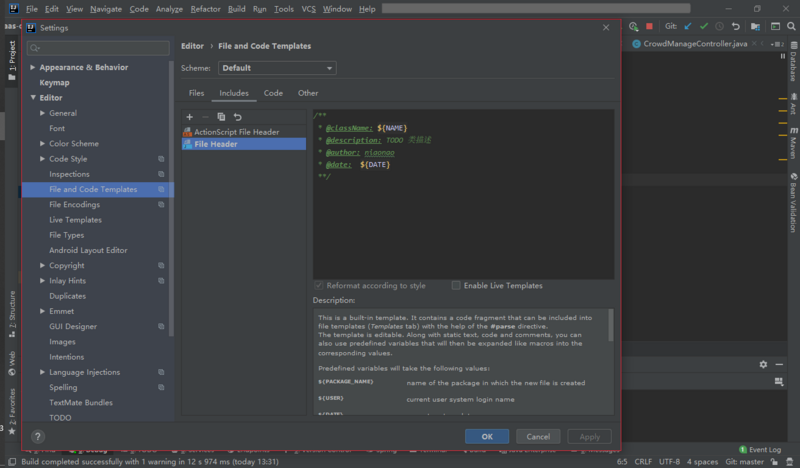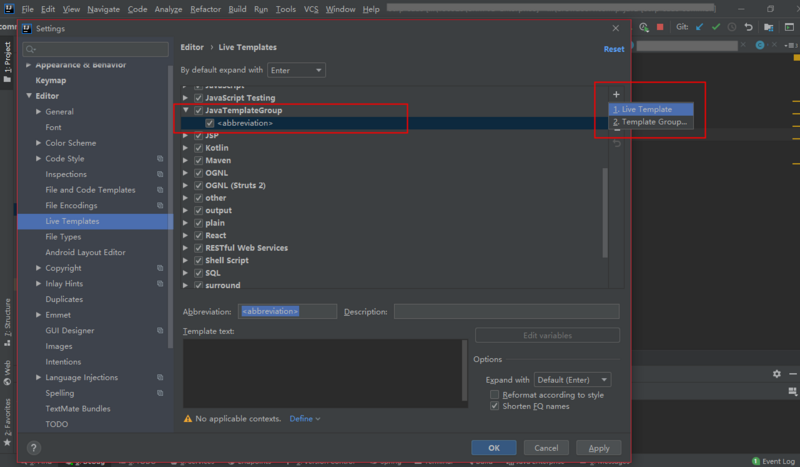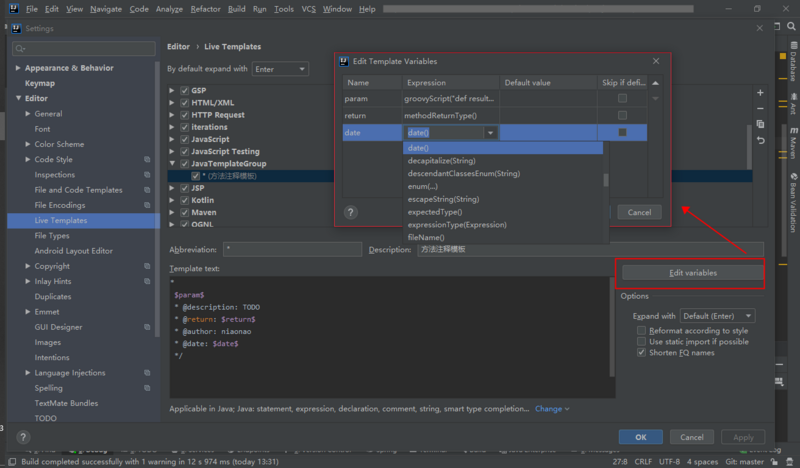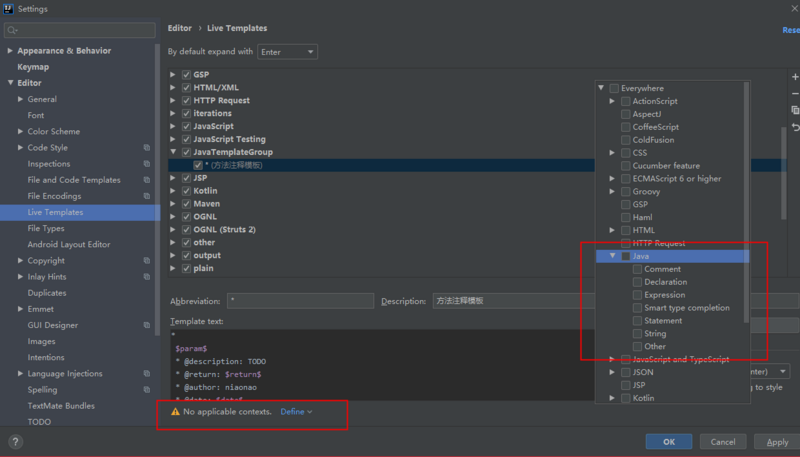代码注释规范-IDEA 配置 Java 类方法注释模板
1. 引言
团队开发时,业务模块分配的越清晰,代码注释管理越完善,越有利于后面维护,后面再管理也方便不少。另外也起着"文字砖"的作用,你懂的。注释不需要很详细,把代码块方法块功能简述一下就行。不然三月后回头看就要骂人了,骂完发现是自己写的,啧啧啧...
三种常用的 Java 注释方式
// 声明常量
int number;
/*
* 类主函数
*/
public static void main(String[] args) {
}
/**
* @param masterId 品牌商Id
* @param shopId 店铺Id
* @param skuId 商品skuId
* @description: 校验商品标识码与店铺的所属关系
* @return: net.jdcloud.APIECRM.model.ValidateSkuUsingGETResponse
* @author: niaonao
* @date: 2020/01/13
*/
public static ValidateSkuUsingGETResponse validateSkuUsing(String masterId, String shopId, String skuId){
return null;
}
2. 自定义注释模板
2.1 类注释模板
2.1.1 配置模板
菜单路径 File-Settings-Editor-File and Code Templates-Incudes-File Header 下添加注释模板,配置模板后点击 Apply OK 应用。

自定义注释模板
/**
* @className: ${NAME}
* @description: TODO 类描述
* @author: niaonao
* @date: ${DATE}
**/
新建接口文件自动生成注释,效果如下
/**
* @className: CrowdService
* @description: 人群对象业务
* @author: niaonao
* @date: 2020/1/13
**/
public interface CrowdService {
}
2.1.2 自定义注释模板不完全变量参考表
| 预定义变量 | 描述信息 |
|---|---|
| ${NAME} | the name of the current file |
| ${PACKAGE_NAME} | name of the package in which the new file is created |
| ${USER} | current user system login name |
| ${DATE} | current system date |
| ${TIME} | current system time |
| ${YEAR} | current year |
| ${MONTH} | current month |
| ${MONTH_NAME_SHORT} | first 3 letters of the current month name. Example: Jan, Feb, etc. |
| ${MONTH_NAME_FULL} | full name of the current month. Example: January, February, etc. |
| ${DAY} | current day of the month |
| ${DAY_NAME_SHORT} | first 3 letters of the current day name. Example: Mon, Tue, etc. |
| ${DAY_NAME_FULL} | full name of the current day. Example: Monday, Tuesday, etc. |
| ${HOUR} | current hour |
| ${MINUTE} | current minute |
| ${PROJECT_NAME} | the name of the current project |
2.2 方法注释模板
2.2.1 配置模板
菜单路径 File-Settings-Editor-Live Templates 下添加一个新模板组,名字自定义 JavaTemplateGroup。选中模板组,右侧点击新增按钮,创建新模板。
- Abbreviation 配置为* 。
- Description 自定义描述信息。
- Template Text 自定义模板
* $param$ * @description: TODO * @return: $return$ * @author: niaonao * @date: $date$ */


Edit variables 编辑变量
- 变量 return 表达式为 methodReturnType()
- 变量 date 表达式为 date()
- 变量 param 表达式为
groovyScript("def result=''; def params=/"${_1}/".replaceAll('[////[|////]|////s]', '').split(',').toList(); for(i = 0; i < params.size(); i++) {result+='* @param: ' + params[i] + ((i < params.size() - 1) ? '//n ' : '')};return result", methodParameters())

若有警告信息 No Applicable contexts,点击 Define 选中 Java 即可。

此处 Expend With 配置为 Enter 回车键,注释生成快捷方式,看个人习惯,也可以时 Tab 键。
点击 Apply OK 应用配置即可。效果如下
/**
* @param: masterId
* @param: shopId
* @param: skuId
* @description: TODO
* @return: net.jdcloud.APIECRM.model.ValidateSkuUsingGETResponse
* @author: niaonao
* @date: 2020/1/13
*/
public static ValidateSkuUsingGETResponse validateSkuUsing(String masterId, String shopId, String skuId) {
return null;
}
2.2.2 补充说明
方法注释模板不可用在,方法外,若用在方法外 @param 获取不到,注释为 @param null;
类注释模板在文件创建时生成,已创建文件不会触发该模板,会触发方法注释模板。
Power By niaonao, The End, Thanks
正文到此结束
热门推荐
相关文章
Loading...










![[HBLOG]公众号](https://www.liuhaihua.cn/img/qrcode_gzh.jpg)

